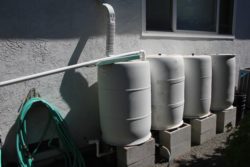Lot size: 1,200 sq. ft. front 75% native, 1,200 sq. ft. back 50% native,
Garden Age: Front garden was installed in 2009; back garden in 2022
Years on the Bringing Back the Natives Garden Tour: 2
Showcase Feature
In 2009 Diane and her hiking buddy, Sally, converted their gardens from solid lawn to water-conserving wildlife habitat gardens together. They took classes as a team, did their research jointly, and just generally helped each other along. Diane, who installed her front garden, cut the lawn into manageable chunks then flipped it over and piled it into mounds, which improved drainage and created visual interest. Plants that provide berries, seeds, and nectar, such as currants and manzanitas, buckwheats and phacelia, and coyote brush and penstemon, were selected. Masses of tansy leaf phacelia create a sea of color in spring. A forty year old buckeye helps keep the house cool in the summer. Diane loves to sit in the shade of the buckeye and enjoy the color and beauty of her garden.
The back garden was designed by Kat Weiss of Kat Weiss Landscape Design. A wide, curving wheelchair accessible path wraps around a raised central garden bed. The lawn was sheet mulched, and later planted with purple-flowering coyote mint, orange monkeyflowers, celestial blue sage, pink rosy buckwheats, and creamy St. Catherine’s lace buckwheat.
Other Garden Attractions
• Diane’s front garden is not watered at all. The native plants in the back garden will be watered by a drip irrigation system for the first two years while the plants are establishing, then they will not be watered, either.
• No pesticides are used in this—or any!—Tour garden. Diane reports that weeds are pulled early and often.
• In the back yard a veggie garden planted in raised beds makes gardening easier.
• Visit the back garden and take a look at Diane’s impressive rainwater catchment system—four 55 gallon barrels mounted on a sturdy rack that provides easy access to the water, which is used in the veggie garden.
Gardening for Wildlife
Multiple birdbaths provide much-needed water for birds. A log from an apricot tree provides shelter to tiny things that need a moist and cool home. Bluebelly and alligator lizards sunbathe on boulders. Scrub jays, mockingbirds, mourning doves, and hummingbirds frequent the garden, as do butterflies and ladybugs.
Rocks, logs, and brush piles provide hiding places for lizards. Ecstatic congregations of native bees gather at the phacelias, foraging for nectar and pollen. Skippers and ladybugs are frequently seen. Hummingbirds are drawn to the native fuchsia and penstemon. Flycatchers swoop through the garden, gracefully catching insects in mid-flight; house finches and goldfinches are welcome visitors. A birdbath and water-filled saucers attract birds and butterflies.
Keystone species in this garden (watch this talk by Doug Tallamy!)
Keystone species—our own, local ecological powerhouse plants— in this garden include California lilac, pink flowering currant, manzanita, buckwheat, sages, and redbud.
At least partially wheelchair accessible? Yes
Green Home Features Summary 
Inspired by the Green Home Features component of the garden tour, Diane installed solar panels, a Bradford White heat pump for heating water, and bought a used electric car.
After her free electrification consultation with Quit Carbon, she purchase a Splitvolt Splitter Switch, which allows Diane to share her dryer socket with her EV charger, giving her 7 times faster charging than a normal wall socket. Diane just plugged her Splitvolt Splitter Switch to the existing 220V – 240V dryer socket, then she plugged the dryer and EV charger into the Splitter Switch, and she got fast, L2 home charging. The Splitvolt Splitter Switch safely and automatically switches full power between the dryer and EV charger.
The Splitvolt was important to Diane, as her panel was maxed out at 100 amps. She can now charge two electric vehicles (Nissan Leaf and Prius PHEV) at once, and one of them charges fast.
Diane reports that it’s been great having an electric car, as she has been free of the gas station sticker shock that many people have been experiencing. As her solar panels generate the energy needed to power the car, she drives for free.
Also, Diane purposely purchased a solar panel system that would a generate more energy than she uses, saying, “I’m happy to be donating the excess energy the panels make to the grid; it makes me feel like I’m being a good citizen.” (Thanks, Diane!)
The oversizing of her solar system is paying off financially, as the energy generated on Diane’s roof last year fully covered her PG&E bill for the year. The cost to power her house and run her car last year was zero.





















